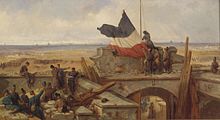Fort de Vanves
Coordinates: 48 ° 48 ′ 42 ″ N , 2 ° 17 ′ 22 ″ E

The Fort de Vanves is one of the 16 individual forts of the Thiers city fortifications of Paris , which should protect the city since the 1840s.
history
The fort was built in 1840 in the municipality of Vanves in what is now the Hauts-de-Seine department . The construction of the city fortifications, initiated by Adolphe Thiers , lay in a ring around the newer quarters of Paris, which had arisen outside the old tariff wall of the general tenants (Mur d'octroi). Today it is about 3.6 km south of the former customs wall in the town of Malakoff , (formerly: Châtillon-sous-Bagneux ), which was separated from Vanves in 1883.
In 1848 the Fort de Vanves served as a prison for hundreds of workers who rose up during the June uprising in 1848 after the closure of the national workshops with the demand for “work and bread”. Their uprising was bloodily suppressed. The workers and their leaders waited months in the fort for their trials, which often ended with death sentences or exile to remote islands in the Pacific .
During the Franco-Prussian War of 1870/71, Fort de Vanves was the starting point for two attempts to break out of the French units trapped in Paris. On September 19, 1870, the advance between the forts of Montrouge and Vanves was unsuccessful. The German opponents fended off this attack by largely newly raised Parisian troops in the battle near Sceaux . In the next few weeks this section of the front was considerably reinforced, fortified and manned with artillery by the Prussian and Bavarian besiegers. The battle of Châtillon on October 13, 1870 began at 8 a.m. with a cannonade by French artillery from the section held by the 5th Royal Bavarian Infantry Regiment in front of Châtillon. However, the German units brought about foiled the attempt to break out.
In January 1871 the Fort de Vanves was surrounded and shot at by the Germans. The occupation did not surrender until January 28, 1871, the day of the surrender of all of Paris.
The large entrance gate of the fort is still there today and is closed with an iron portal.
Todays use
The area is no longer of military importance today, but is the seat of the leadership of the French Reservist Association, CSRM .
The Direction de la protection et de la sécurité de la défence (DPSD), the organization of the French armed forces entrusted with counter-espionage, is also located there.